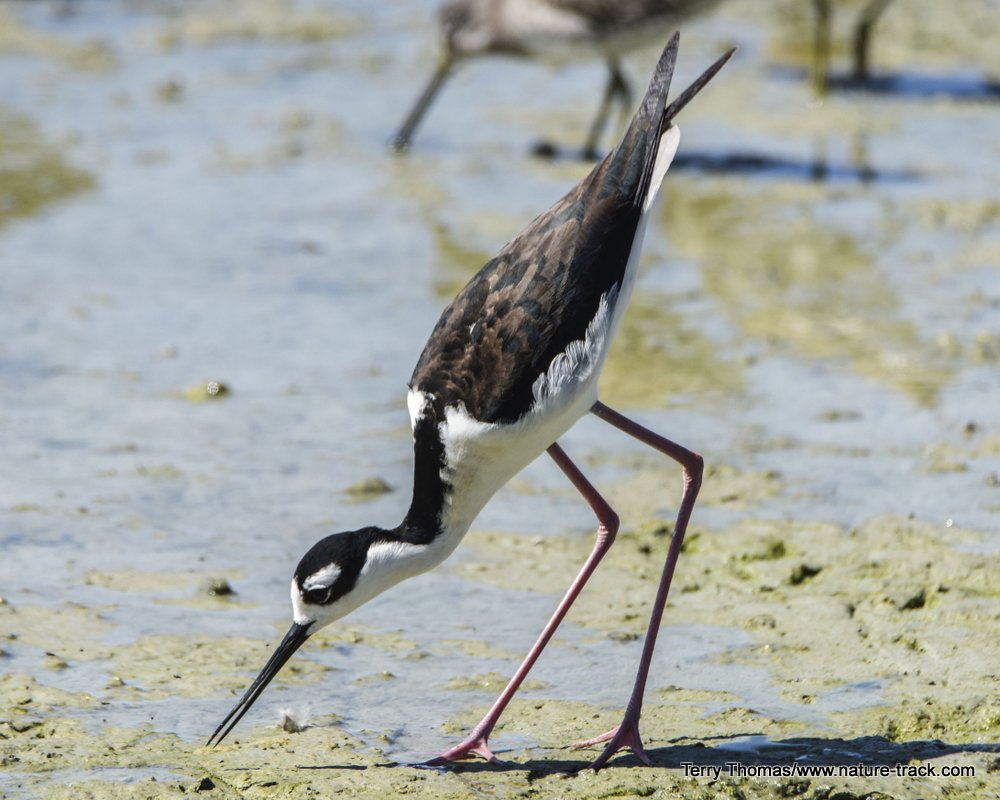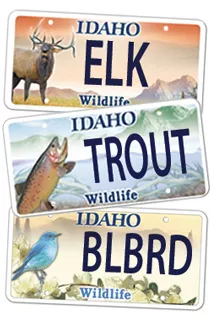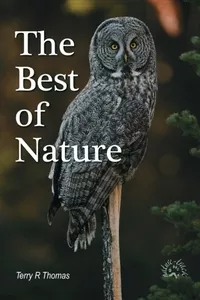Black-necked Stilt

A black-necked stilt female reaches for a morsel of food with its long slim bill.
Penguins and stilts are two genera of birds that seem to be dressed for a formal ball. That, however, is just about where the similarities end. Penguins are stout, clumsy on shore, and despite their dress, they are not exactly the model of elegance.
Stilts, on the other hand, have an almost regal bearing that accentuates their “tuxedo” attire of black and white. Their movements are spare and graceful and precise. There are five species of stilts, but the one that graces our waters is the black-necked stilt.
The black-necked stilt is unmistakable. It has long reddish legs (the second longest leg to body ratio in the bird world, only behind the flamingo) so long that they look like they are on stilts—hence the name, a black back and wings that carries up the neck and onto the head, and a white belly, chest throat and forehead and a white spot over a red eye. They are a slender bird with a pointy black bill. In the right light, males will show a glossy green iridescence in their wings while females will be more brownish. Otherwise, sexes are similar.
The black-necked stilt has a spotty disjunct seasonal breeding range that includes southern Idaho and northern Utah, much of Nevada, and parts of Montana, Oregon, Colorado, northern California, Washington, and New Mexico. They are year-round residents in coastal California and along the Gulf Coast.
The stilt is a bird of the wetlands where it uses its long legs to stalk through shallow water to hunt for small prey. They hunt slowly, which adds to their stately air, but that doesn’t mean that they are lackluster birds. Considered semi-colonial, they tend to nest in large groups where they band together to drive off predators, humans included. It is not unheard of for black-necked stilt to club unsuspecting researchers in the head with their feet as they fly over them. For other predators, a group may encircle the predator and intimidate it by leaping up and down, flapping their wings and calling loudly, a behavior researchers call a “popcorn display.”
Black-necked stilts belong to the same family (Recurvirostridae) as another wetland beauty, the American avocet. These two are so closely related that they occasionally hybridize and produce young, which birders have named the “avo-stilt.”
The diet of the black-necked stilt is nearly 100 percent protein-based. They eat invertebrates such as fly and mosquito larva, small crustaceans, beetles, crayfish and brine shrimp. They also eat tiny frogs, tadpoles, and fish. Vegetation and seeds are a very small, possibly accidental, part of the diet.
It is refreshing to note that the North American Breeding Bird Survey has found black-necked stilt populations to have been stable between 1966 and 2015 in continental North America. In a few places elsewhere, numbers have even increased slightly. Only the Hawaiian subspecies of black-necked stilt is still in trouble and listed as endangered, but even then, the population has gained ground.
As with most shorebirds, black-necked stilt migration begins by late July. Birds that we see now may not be our resident breeders, but rather, birds migrating through. By the end of September, we will have to travel to Texas, southern Arizona or the Gulf Coast to find them.
If you get a chance to see a black-necked stilt, it will be worth your while to spend a few minutes just observing these showy regal birds. They add a touch of glamor to any wetland.
Help Idaho Wildlife
When we traveled across the state in October 2017, most of the vehicles we saw using the wildlife management areas did not have wildlife plates. Buying wildlife plates is a great way for non-hunters and hunters alike to support wildlife-based recreation like birding.
C'mon folks, let's help Idaho's wildlife by proudly buying and displaying a wildlife license plate on each of our vehicles!
See below for information on Idaho plates. Most states have wildlife plates so if you live outside Idaho, check with your state's wildlife department or vehicle licensing division for availability of state wildlife plates where you live.
And tell them that you heard about it from Nature-track.com!

Wildlife License Plates
Great news! as of 2024, there are three NEW designs for license plates. They still are bluebird, cutthroat trout and elk, but they are beautiful.
Idaho Wildlife license plates provide essential funding that benefits the great diversity of native plants and wildlife that are not hunted, fished or trapped—over 10,000 species or 98% of Idaho’s species diversity. Game species that share the same habitats (such as elk, deer, antelope, sage-grouse, salmon, trout) also benefit from these specialty plates.
No state tax dollars are provided for wildlife diversity, conservation education and recreation programs. Neither are any revenues from the sale of hunting or fishing licenses spent on nongame species. Instead, these species depend on direct donations, federal grants, fundraising initiatives—and the Idaho Wildlife license plates.
Both my vehicles have Bluebird Plates. I prefer the bluebird because the nongame program gets 70 percent of the money from bluebird plates, but only 60 percent of the money from elk and trout plates - 10 percent of the money from elk plates supports wildlife disease monitoring and testing programs (to benefit the livestock industry) and 10 percent from cutthroat plates supports non-motorized boat access.
Incidentally, in 2014, the Idaho Legislature denied the Department of Fish and Game the ability to add new plates or even to change the name of the elk and cutthroat plates (very specific) to wildlife and fish plates, a move that would have allowed for changing images occasionally and generating more revenue. It would seem that they believe that we Idahoans don't want a well funded wildlife program.
I think it is time we let the Legislature know that Idahoan support wildlife funding and that we would like to see these generic plates come to fruition.

"WOW. What a phenomenal piece you wrote. You are amazing." Jennifer Jackson
That is embarrassing, but actually a fairly typical response to my nature essays. Since The Best of Nature is created from the very best of 16 years of these nature essays published weekly in the Idaho Falls Post Register (online readership 70,000), it is a fine read. It covers a wide variety of topics including humorous glimpses of nature, philosophy, natural history, and conservation. Readers praise the style, breadth of subject matter and my ability to communicate complex and emotional topics in a relaxed and understandable manner.
Everyone can find something to love in this book. From teenagers to octogenarians, from the coffee shop to the school room, these nature essays are widely read and enjoyed.
Some of the essays here are my personal favorites, others seemed to strike a chord with readers. Most have an important message or lesson that will resonate with you. They are written with a goal to simultaneously entertain and educate about the wonderful workings of nature. Some will make you laugh out loud and others will bring a tear to the eye and warm your heart.
Readers Write:
"You hit a home run with your article on, Big Questions in Nature. It should be required reading for everyone who has lost touch with nature...great job!" Joe Chapman
"We enjoyed your column, Bloom Where Planted. Some of the best writing yet. The Post Register is fortunate to have your weekly columns." Lou Griffin.
To read more and to order a copy, click here or get the Kindle version
Copies are also available at:
Post Register
Island Park Builders Supply (upstairs)
Barnes and Noble in Idaho Falls
Harriman State Park, Island Park
Museum of Idaho
Valley Books, Jackson Wyoming
Avocet Corner Bookstore, Bear River National Wildlife Refuge, Brigham City, Utah
Craters of the Moon National Monument Bookstore, Arco, Idaho